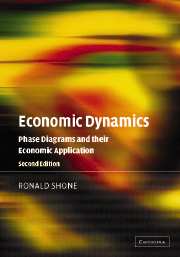Book contents
- Frontmatter
- Contents
- Preface to the second edition
- Preface to the first edition
- PART I Dynamic modelling
- PART II Applied economic dynamics
- 8 Demand and supply models
- 9 Dynamic theory of oligopoly
- 10 Closed economy dynamics
- 11 The dynamics of inflation and unemployment
- 12 Open economy dynamics: sticky price models
- 13 Open economy dynamics: flexible price models
- 14 Population models
- 15 The dynamics of fisheries
- Answers to selected exercises
- Bibliography
- Author index
- Subject index
8 - Demand and supply models
Published online by Cambridge University Press: 05 June 2012
- Frontmatter
- Contents
- Preface to the second edition
- Preface to the first edition
- PART I Dynamic modelling
- PART II Applied economic dynamics
- 8 Demand and supply models
- 9 Dynamic theory of oligopoly
- 10 Closed economy dynamics
- 11 The dynamics of inflation and unemployment
- 12 Open economy dynamics: sticky price models
- 13 Open economy dynamics: flexible price models
- 14 Population models
- 15 The dynamics of fisheries
- Answers to selected exercises
- Bibliography
- Author index
- Subject index
Summary
Introduction
Every student of economics is introduced to demand and supply and from then it becomes a major tool of analysis, both at the microeconomic and macroeconomic level. But the treatment is largely static, with the possible exception of the cobweb model. But even when teaching this subject to first-year students, there is something unsatisfactory about the textbook analysis. Consider the situation shown in figure 8.1, where D denotes the demand curve and S the supply curve. We have a single market and the analysis is partial, i.e., this is the only market under investigation. For simplicity we also assume that the demand and supply curves have conventional slopes and are linear.
Suppose the price is presently P0. What happens? The typical textbook argument is that there is excess demand at this price and so suppliers, noting they can sell all they wish, will raise the price. This process will continue until the market is in equilibrium and there is no longer excess demand. But what is going on during this process? At the price P0 do we assume that demand is not satisfied and that the quantity actually transacted is Q0, but that in the next period the price is higher? Or do we assume that these curves indicate market wishes on the part of demanders and suppliers and that such excess demand is a signal to the market that a better deal can be struck?
- Type
- Chapter
- Information
- Economic DynamicsPhase Diagrams and their Economic Application, pp. 325 - 374Publisher: Cambridge University PressPrint publication year: 2002



